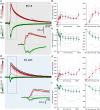This is a preprint.
Hippocampus shapes cortical sensory output and novelty coding through a direct feedback circuit
- PMID: 37674706
- PMCID: PMC10479401
- DOI: 10.21203/rs.3.rs-3270016/v1
Hippocampus shapes cortical sensory output and novelty coding through a direct feedback circuit
Update in
-
Hippocampus shapes entorhinal cortical output through a direct feedback circuit.Nat Neurosci. 2025 Apr;28(4):811-822. doi: 10.1038/s41593-025-01883-9. Epub 2025 Feb 18. Nat Neurosci. 2025. PMID: 39966537
Abstract
To extract behaviorally relevant information from our surroundings, our brains constantly integrate and compare incoming sensory information with those stored as memories. Cortico-hippocampal interactions could mediate such interplay between sensory processing and memory recall1-4 but this remains to be demonstrated. Recent work parsing entorhinal cortex-to-hippocampus circuitry show its role in episodic memory formation5-7 and spatial navigation8. However, the organization and function of the hippocampus-to-cortex back-projection circuit remains uncharted. We combined circuit mapping, physiology and behavior with optogenetic manipulations, and computational modeling to reveal how hippocampal feedback modulates cortical sensory activity and behavioral output. Here we show a new direct hippocampal projection to entorhinal cortex layer 2/3, the very layer that projects multisensory input to the hippocampus. Our finding challenges the canonical cortico-hippocampal circuit model where hippocampal feedback only reaches entorhinal cortex layer 2/3 indirectly via layer 5. This direct hippocampal input integrates with cortical sensory inputs in layer 2/3 neurons to drive their plasticity and spike output, and provides an important novelty signal during behavior for coding objects and their locations. Through the sensory-memory feedback loop, hippocampus can update real-time cortical sensory processing, efficiently and iteratively, thereby imparting the salient context for adaptive learned behaviors with new experiences.
Keywords: Behavior; Electrophysiology; Memory; Optogenetics; Plasticity; Rabies virus.
Conflict of interest statement
Competing interests: Authors declare that they have no competing interests.
Figures













References
-
- Suh J., Rivest A. J., Nakashiba T., Tominaga T. & Tonegawa S. Entorhinal cortex layer III input to the hippocampus is crucial for temporal association memory. Science 334, 1415–1420 (2011). - PubMed
-
- Igarashi K. M., Lu L., Colgin L. L., Moser M.-B. & Moser E. I. Coordination of entorhinal-hippocampal ensemble activity during associative learning. Nature 510, 143–147 (2014). - PubMed
-
- Remondes M. & Schuman E. M. Role for a cortical input to hippocampal area CA1 in the consolidation of a long-term memory. Nature 431, 699–703 (2004). - PubMed
Publication types
Grants and funding
LinkOut - more resources
Full Text Sources
Research Materials

